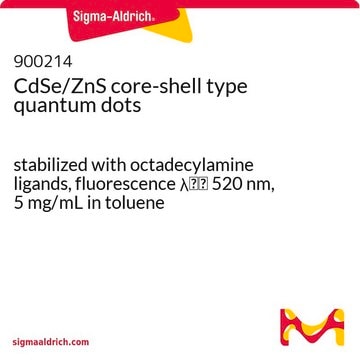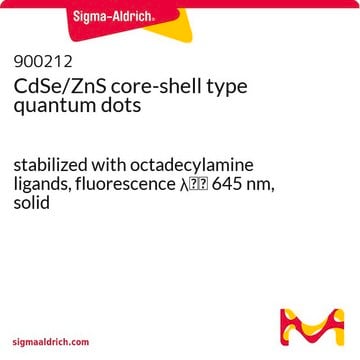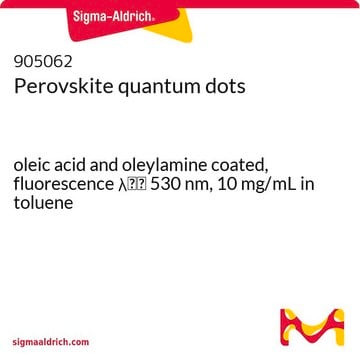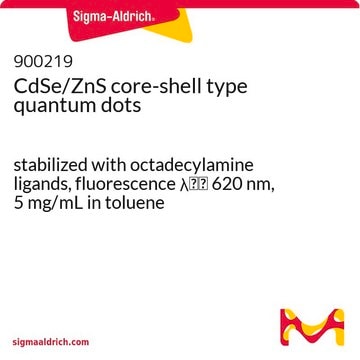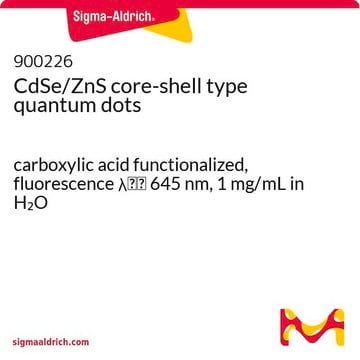The particle density is not determined for this product.
790192
CdSe/ZnS core-shell type quantum dots
stabilized with octadecylamine ligands, fluorescence λem 620 nm, solid
Synonym(s):
Artificial atoms, Fluorescent nanocrystals, QDs
Select a Size
Select a Size
About This Item
Recommended Products
Looking for similar products? Visit Product Comparison Guide
Application
Protocol to make QD solutions (dispersing QDs into solutions):
1. Weigh desired amount of the quantum dot powder and put it in a glass vial;
2. Add desired amount of the solvent, i.e. toluene, chloroform, hexane, etc. (mostly non-polar organic solvents) in the vial and shake the vial;
3. If there is any solid left in the vial after shaking, sonicate the vial for 30~60 seconds to get the quantum dot powder well dispersed. If required dilute the solution further.
Material has a shelf life of around 3 years if stored properly. Store at room temperature (4-25 °C); do not freeze. Should not be exposed to extreme temperatures.
Legal Information
signalword
Danger
Hazard Classifications
Acute Tox. 4 Inhalation - Acute Tox. 4 Oral - Aquatic Acute 1 - Aquatic Chronic 1 - Eye Dam. 1 - Skin Irrit. 2 - STOT RE 2 - STOT RE 2 Oral
target_organs
Kidney,Bone, Liver,Gastrointestinal tract,Immune system
supp_hazards
Storage Class
11 - Combustible Solids
wgk_germany
WGK 3
flash_point_f
Not applicable
flash_point_c
Not applicable
Choose from one of the most recent versions:
Already Own This Product?
Find documentation for the products that you have recently purchased in the Document Library.
Customers Also Viewed
Articles
Quantum dots are tiny particles or nanocrystals of a semiconducting material with diameters in the range of 2-10 nanometers.
Dye-sensitized solar cells as a promising, low-cost photovoltaic technology.
Professor Sharma and colleagues review the synthesis and applications of this novel material. This includes a discussion of the unique properties of quantum dots and their suitability for solar cell applications, along with common synthesis techniques used to develop these materials.
Professor Xiaohu Gao (University of Washington, USA) provides a overview of recent quantum dot (QD) advancements and their potential for advancing bioassay and bioimaging technologies.
-
What is the particle density for product 790192, CdSe/ZnS core-shell quantum dots?
1 answer-
Helpful?
-
-
What is the molecular weight of CdSe/ZnS core-shell type quantum dots, and what is the recommended method for their dissolution?
1 answer-
The molecular weight information for CdSe/ZnS core-shell type quantum dots is typically not provided in the QD field, as it can be calculated based on the quantum effect via size. The recommended solvents for dissolving CdSe/ZnS core-shell type quantum dots include chloroform, toluene, xylene, and THF. The procedure for dissolution involves adding the solvent to the QD solid, shaking it for 3 minutes, and sonication for 20 seconds if the QDs are not completely dispersed. If toluene is the solvent, any grade of toluene can be used. No specific equipment is needed for dissolving CdSe/ZnS core-shell type quantum dots; shaking the vial is sufficient.
Helpful?
-
-
What is the particle size and shell size for product 790192, CdSe/ZnS core-shell quantum dots?
1 answer-
The particle size of the core and shell is about 8 nm and that of the surface ligand is 2 nm.
Helpful?
-
-
What is the Department of Transportation shipping information for this product?
1 answer-
Transportation information can be found in Section 14 of the product's (M)SDS.To access the shipping information for this material, use the link on the product detail page for the product.
Helpful?
-
Active Filters
Our team of scientists has experience in all areas of research including Life Science, Material Science, Chemical Synthesis, Chromatography, Analytical and many others.
Contact Technical Service
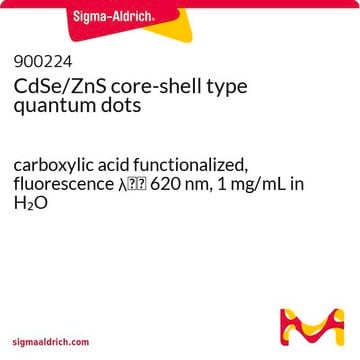

![(Ir[dF(CF3)ppy]2(dtbpy))PF6](/deepweb/assets/sigmaaldrich/product/structures/982/913/02dd8ddd-6deb-40a0-ab9b-07b18f1abb09/640/02dd8ddd-6deb-40a0-ab9b-07b18f1abb09.png)
